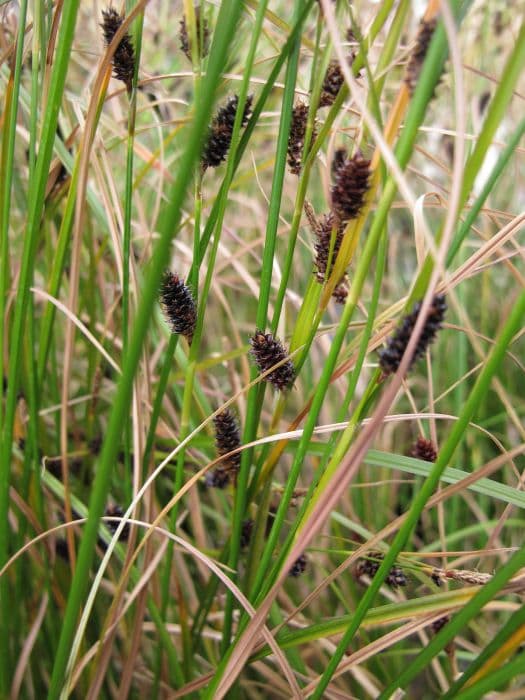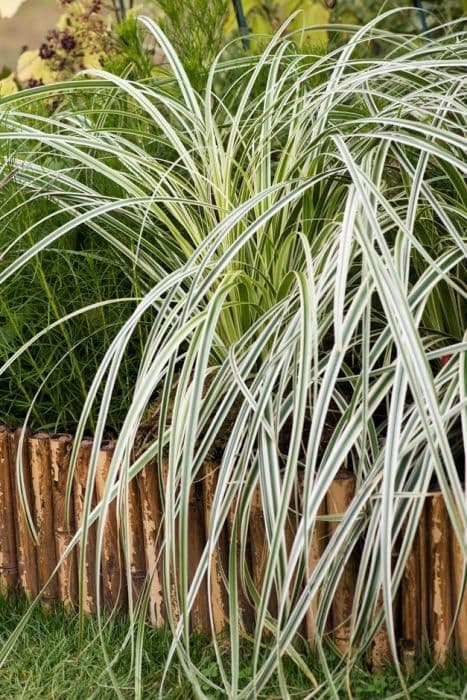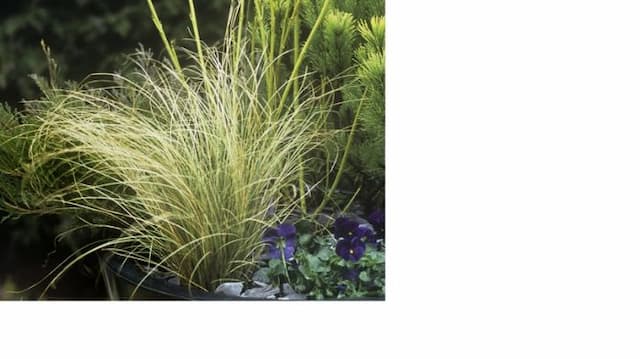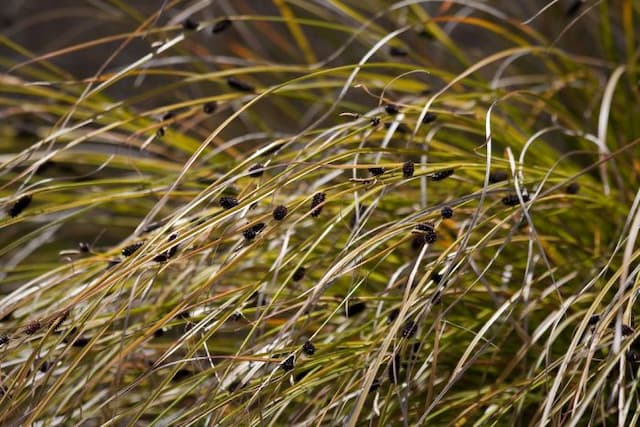Red hook sedge Uncinia rubra

ABOUT
The plant known as Red Hook Sedge has a distinctive appearance marked by its richly colored foliage. It features leaves that have a striking reddish-brown hue, sometimes with a fiery undertone, which captures the eye and adds a touch of warm color to the plant's surroundings. The texture of the leaves is fine yet slightly rigid, providing a grass-like look with a subtle sheen that can catch the light and create a visual sparkle. The overall form of the Red Hook Sedge is tufted, with the leaves emerging in a clumped or clustered fashion, giving it a compact and dense structure. This configuration allows the leaves to arch elegantly, creating a cascading effect that adds to the plant's ornamental charm. Red Hook Sedge produces flower spikes that may not be as showy as its foliage but do contribute additional interest to its profile. These flower spikes bear a resemblance to the rest of the plant in terms of color but can have a lighter or sometimes more intense coloration. The contrast between the dark, reddish foliage and the more subtle hues of the flowering parts creates a pleasing interplay of tones. Overall, Red Hook Sedge is admired for its captivating color and graceful form, making it a popular choice for gardeners looking to add a splash of color and texture to their landscape. Its appearance lends itself to a variety of settings, from contemporary gardens to more naturalized areas, highlighting its versatility as a decorative plant.
About this plant
 Names
NamesFamily
Cyperaceae
Synonyms
Red Hook Sedge, Firedance Hook Sedge
Common names
Carex rubra, Uncinia uncinata var. rubra.
 Toxicity
ToxicityTo humans
Uncinia rubra, commonly known as Red Hook Sedge, is not widely documented as toxic to humans. There have been no significant reports or studies indicating that this plant, when touched or ingested, causes toxic reactions in humans. However, it is generally advisable to avoid ingesting plants that are not commonly recognized as edible, as they may cause gastrointestinal discomfort or allergic reactions in some individuals.
To pets
Red Hook Sedge is not known to be toxic to pets. There is limited information available on the potential effects of this plant on animals, but it does not appear on common lists of plants that are poisonous to pets, such as dogs and cats. Nevertheless, as with humans, it is usually good practice to prevent pets from ingesting ornamental plants as they could potentially cause mild gastrointestinal upsets or allergic reactions.
 Characteristics
CharacteristicsLife cycle
Perennials
Foliage type
Evergreen
Color of leaves
Red
Height
1-2 feet (30-60 cm)
Spread
1 foot (30 cm)
Plant type
Grass
Hardiness zones
8
Native area
New Zealand
Benefits
 General Benefits
General Benefits- Aesthetic Appeal: Adds vibrant color and texture to gardens with its reddish-brown leaves.
- Low Maintenance: Requires minimal care once established, tolerating a range of soil conditions.
- Drought Tolerance: Can survive dry periods, making it suitable for xeriscaping.
- Erosion Control: Its root system helps stabilize soil on slopes and banks.
- Cold Hardy: Capable of withstanding cooler temperatures and frosts.
- Attracts Wildlife: Provides habitat and food for birds and insects.
- Ground Cover: Dense growth habit can suppress weeds and cover bare spots.
- Ornamental Grass: Popular in modern landscaping for form and year-round interest.
- Companion Planting: Complements other plants in gardens and containers without dominating.
- Seasonal Interest: Offers changing hues through seasons, enhancing garden aesthetics.
 Medical Properties
Medical PropertiesThis plant is not used for medical purposes.
 Air-purifying Qualities
Air-purifying QualitiesThis plant is not specifically known for air purifying qualities.
 Other Uses
Other Uses- Ornamental Landscape Design: Uncinia rubra, commonly known as the Red Hook Sedge, is frequently used in garden designs for its striking reddish-bronze foliage that adds color contrast.
- Container Gardening: Due to its compact size and unique color, the Red Hook Sedge is suitable for use in containers, either alone or as part of a mixed arrangement.
- Erosion Control: Its dense mat of roots can help stabilize soil in areas prone to erosion, such as slopes or stream banks.
- Ground Cover: Red Hook Sedge can be planted en masse to form an attractive, low-maintenance ground cover that requires minimal care once established.
- Accent Planting: Gardeners may use it as an accent plant in rock gardens or along borders to highlight its unique color and texture.
- Ecological Projects: It can be incorporated into rewilding and habitat restoration projects, especially in moist areas where it can thrive and support local ecosystems.
- Winter Interest: The plant's evergreen foliage provides visual interest in the garden during the winter months when many plants are dormant.
- Companion Planting: The Red Hook Sedge pairs well with other moisture-loving plants, creating diverse and visually appealing wetland gardens.
- Photography: Its striking appearance makes Uncinia rubra a favored subject for botanical photography and art.
- Themed Gardens: It can be used in Asian-themed gardens or in compositions that aim to mimic the natural landscapes of New Zealand, where the plant originates.
Interesting Facts
 Feng Shui
Feng ShuiThe Red Hook Sedge is not used in Feng Shui practice.
 Zodiac Sign Compitability
Zodiac Sign CompitabilityThe Red Hook Sedge is not used in astrology practice.
 Plant Symbolism
Plant Symbolism- Rarity: Uncinia rubra, commonly known as the Red Hook Sedge, is not a widespread or commonly referenced plant in popular symbolism. Its relative obscurity may symbolize uniqueness or the value of rare traits.
- Resilience: As a sedge plant that can thrive in various conditions, it may represent adaptability and the ability to withstand difficult environments.
- Attention to Detail: The plant's distinctive red-tinged leaves and hooks can denote the importance of the finer details in life or the idea that small features can have a big impact.
 Water
WaterThe Red Hook Sedge (common name for Uncinia rubra) prefers consistently moist soil, so it's important to water it regularly. Aim to water the plant deeply once a week, providing about 1-2 gallons depending on the size of the plant and the weather conditions. During hot, dry periods, it might require watering twice a week. In cooler or rainy climates, reduce watering to prevent waterlogging. Always check the top inch of soil for dryness before watering to avoid overwatering.
 Light
LightRed Hook Sedge thrives in partial shade to full sun, so the best spot for this plant would be where it can receive sunlight for at least a few hours a day. Avoid placing it in deep shade or direct, scorching sunlight, as both extremes can result in poor growth or foliage burn. An area with dappled sunlight or morning sun followed by afternoon shade would be ideal.
 Temperature
TemperatureThe Red Hook Sedge does well in a broad range of temperature conditions, surviving in temperatures as low as 20°F and as high as 90°F. However, the ideal temperature range for this perennial is between 60°F and 75°F. Do not expose the plant to prolonged periods of frost, as it may not be hardy below 20°F.
 Pruning
PruningPrune the Red Hook Sedge to remove dead or damaged foliage and to maintain its shape. This can be done in late winter or early spring before new growth begins. Pruning once a year is typically sufficient. The best time for pruning is just before the plant comes out of dormancy to allow fresh, new leaves to fill in.
 Cleaning
CleaningAs needed
 Soil
SoilThe best soil mix for Uncinia rubra, commonly known as Red Hook Sedge, should be well-draining and rich in organic matter. A mix of peat, coarse sand, and loam works well. Maintain a slightly acidic to neutral pH of 6.0 to 7.0 for optimal growth.
 Repotting
RepottingRed Hook Sedge does not require frequent repotting and can typically be repotted every two to three years. It's best to repot only when the plant has outgrown its current container or the soil appears degraded.
 Humidity & Misting
Humidity & MistingRed Hook Sedge thrives in moderate to high humidity levels. Aim to maintain a humidity range of around 50-70% for the best growth conditions.
 Suitable locations
Suitable locationsIndoor
Provide bright indirect light and keep the soil moist.
Outdoor
Plant in partial shade and protect from strong winds.
Hardiness zone
8-10 USDA
 Life cycle
Life cycleUncinia rubra, commonly known as Red Hook Sedge, begins its lifecycle as a seed, which germinates in moist conditions with ample light. The seedling stage involves the emergence of grass-like shoots and roots. As it enters the vegetative growth stage, it forms tufts with narrow, reddish-brown leaves and a clumping habit. The reproductive phase follows, marked by the development of spikelets with reddish-brown hooks that help in seed dispersal by catching onto animal fur or feathers. After pollination and seed set, the plant goes dormant during unfavorable conditions, typically in winter, awaiting spring to resume growth. Its perennial nature allows Red Hook Sedge to undergo this lifecycle repeatedly for several years.
 Propogation
PropogationPropogation time
Spring-early summer
Propogation: The most popular method of propagating Uncinia rubra, commonly known as Red Hook Sedge, is through division. This process typically takes place in the spring or early summer when the plant is actively growing. Division involves carefully taking the plant out of the ground and splitting it into smaller sections, ensuring each new section has a portion of the roots attached. These sections can then be immediately replanted into moist, well-drained soil at the same depth they were originally growing. It's crucial to water the new plants thoroughly after planting to encourage establishment in their new location. This method is favored because it maintains the true characteristics of the parent plant and allows for a relatively quick increase in the number of plants.









